Topics in IT Ethics: Analysis of Law on Violent Images Online
VerifiedAdded on 2021/06/15
|7
|2120
|15
Essay
AI Summary
This assignment delves into the ethical considerations surrounding the South Australian government's proposed law against uploading violent images on the internet. The paper examines the issue through the lens of several ethical theories, including utilitarianism, deontology, virtue ethics, and contract theory. It analyzes the potential impact of the law on freedom of speech and the balance between protecting individuals from harm and allowing open communication. The assignment explores the arguments for and against the legislation, considering the intentions behind posting such content and the potential consequences. The analysis covers the government's role, the rights of internet users, and the complexities of regulating online content. The essay further discusses the ethical dilemmas faced by the government in balancing the need for public safety with the protection of individual rights and expression. It also considers various options, such as monitoring online activities, implementing the law with amendments, and the implications of each approach. Overall, the assignment provides a comprehensive ethical analysis of the proposed law and its potential effects on society.
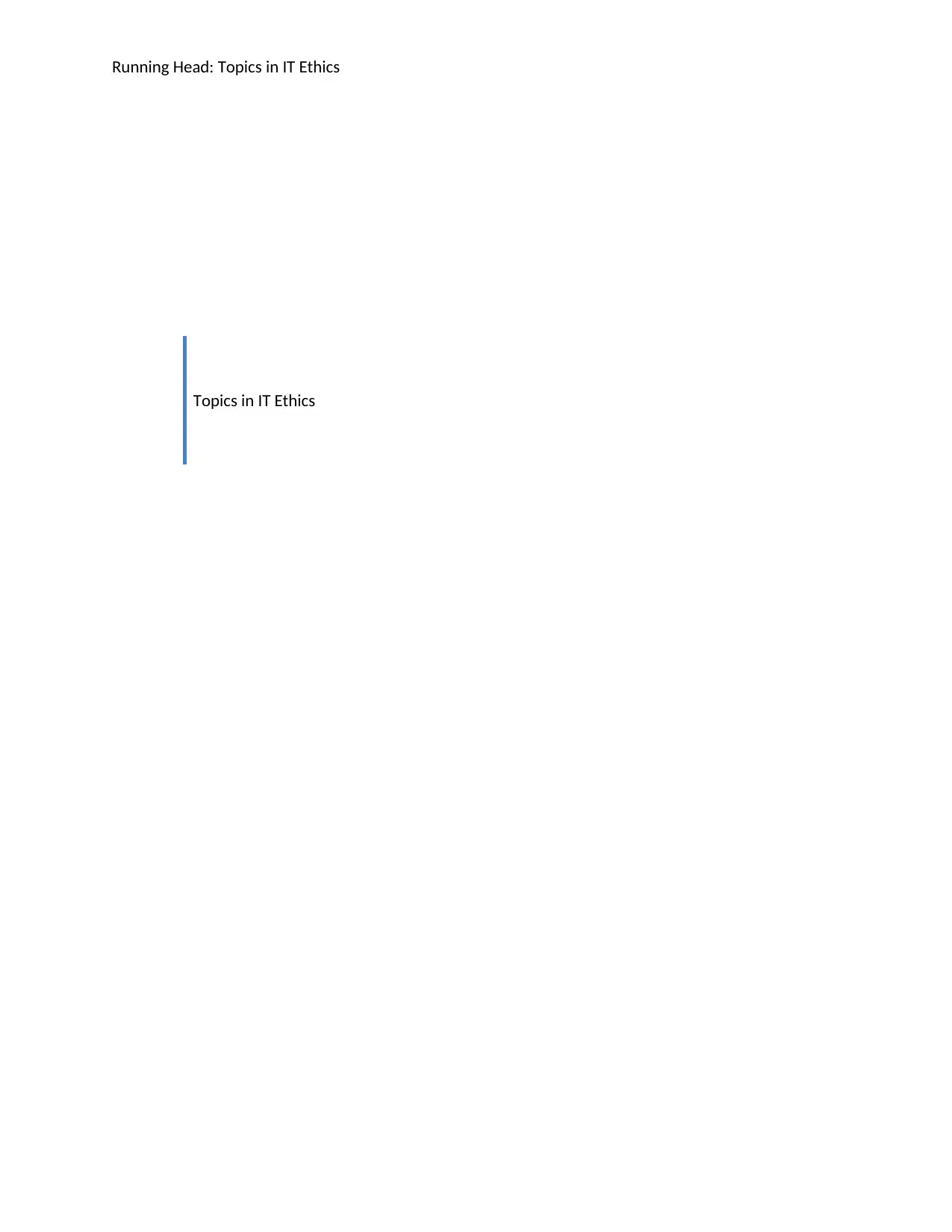
Running Head: Topics in IT Ethics
Topics in IT Ethics
Topics in IT Ethics
Paraphrase This Document
Need a fresh take? Get an instant paraphrase of this document with our AI Paraphraser
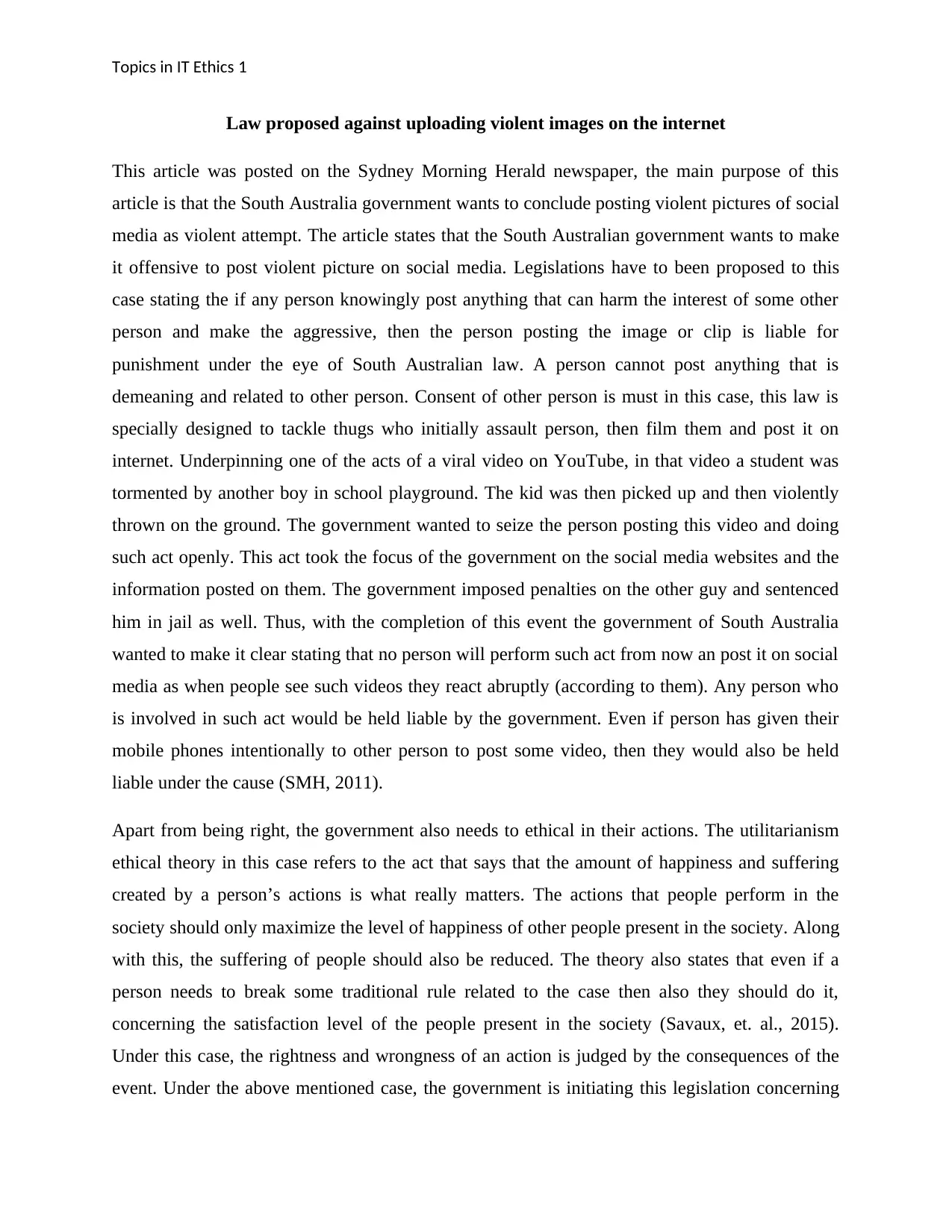
Topics in IT Ethics 1
Law proposed against uploading violent images on the internet
This article was posted on the Sydney Morning Herald newspaper, the main purpose of this
article is that the South Australia government wants to conclude posting violent pictures of social
media as violent attempt. The article states that the South Australian government wants to make
it offensive to post violent picture on social media. Legislations have to been proposed to this
case stating the if any person knowingly post anything that can harm the interest of some other
person and make the aggressive, then the person posting the image or clip is liable for
punishment under the eye of South Australian law. A person cannot post anything that is
demeaning and related to other person. Consent of other person is must in this case, this law is
specially designed to tackle thugs who initially assault person, then film them and post it on
internet. Underpinning one of the acts of a viral video on YouTube, in that video a student was
tormented by another boy in school playground. The kid was then picked up and then violently
thrown on the ground. The government wanted to seize the person posting this video and doing
such act openly. This act took the focus of the government on the social media websites and the
information posted on them. The government imposed penalties on the other guy and sentenced
him in jail as well. Thus, with the completion of this event the government of South Australia
wanted to make it clear stating that no person will perform such act from now an post it on social
media as when people see such videos they react abruptly (according to them). Any person who
is involved in such act would be held liable by the government. Even if person has given their
mobile phones intentionally to other person to post some video, then they would also be held
liable under the cause (SMH, 2011).
Apart from being right, the government also needs to ethical in their actions. The utilitarianism
ethical theory in this case refers to the act that says that the amount of happiness and suffering
created by a person’s actions is what really matters. The actions that people perform in the
society should only maximize the level of happiness of other people present in the society. Along
with this, the suffering of people should also be reduced. The theory also states that even if a
person needs to break some traditional rule related to the case then also they should do it,
concerning the satisfaction level of the people present in the society (Savaux, et. al., 2015).
Under this case, the rightness and wrongness of an action is judged by the consequences of the
event. Under the above mentioned case, the government is initiating this legislation concerning
Law proposed against uploading violent images on the internet
This article was posted on the Sydney Morning Herald newspaper, the main purpose of this
article is that the South Australia government wants to conclude posting violent pictures of social
media as violent attempt. The article states that the South Australian government wants to make
it offensive to post violent picture on social media. Legislations have to been proposed to this
case stating the if any person knowingly post anything that can harm the interest of some other
person and make the aggressive, then the person posting the image or clip is liable for
punishment under the eye of South Australian law. A person cannot post anything that is
demeaning and related to other person. Consent of other person is must in this case, this law is
specially designed to tackle thugs who initially assault person, then film them and post it on
internet. Underpinning one of the acts of a viral video on YouTube, in that video a student was
tormented by another boy in school playground. The kid was then picked up and then violently
thrown on the ground. The government wanted to seize the person posting this video and doing
such act openly. This act took the focus of the government on the social media websites and the
information posted on them. The government imposed penalties on the other guy and sentenced
him in jail as well. Thus, with the completion of this event the government of South Australia
wanted to make it clear stating that no person will perform such act from now an post it on social
media as when people see such videos they react abruptly (according to them). Any person who
is involved in such act would be held liable by the government. Even if person has given their
mobile phones intentionally to other person to post some video, then they would also be held
liable under the cause (SMH, 2011).
Apart from being right, the government also needs to ethical in their actions. The utilitarianism
ethical theory in this case refers to the act that says that the amount of happiness and suffering
created by a person’s actions is what really matters. The actions that people perform in the
society should only maximize the level of happiness of other people present in the society. Along
with this, the suffering of people should also be reduced. The theory also states that even if a
person needs to break some traditional rule related to the case then also they should do it,
concerning the satisfaction level of the people present in the society (Savaux, et. al., 2015).
Under this case, the rightness and wrongness of an action is judged by the consequences of the
event. Under the above mentioned case, the government is initiating this legislation concerning
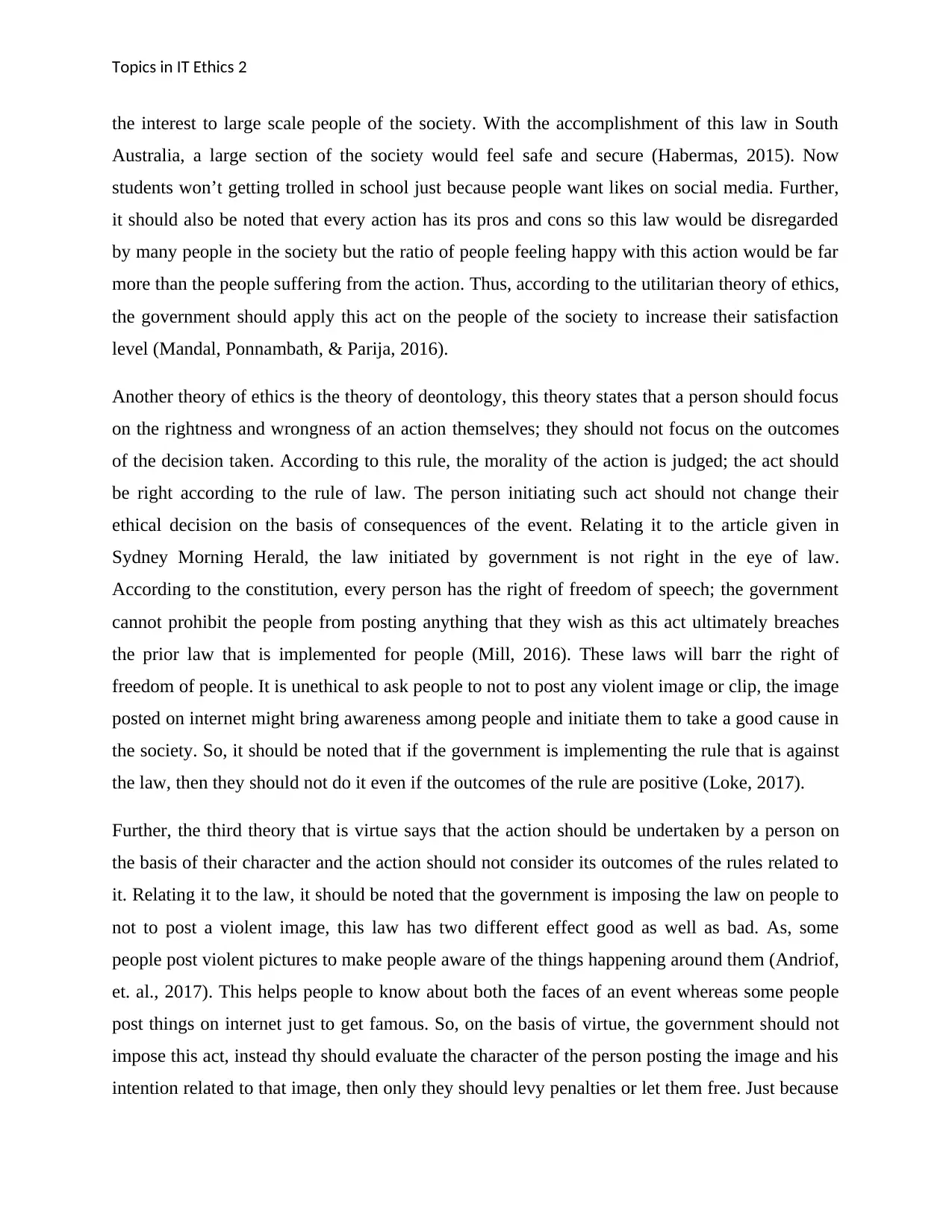
Topics in IT Ethics 2
the interest to large scale people of the society. With the accomplishment of this law in South
Australia, a large section of the society would feel safe and secure (Habermas, 2015). Now
students won’t getting trolled in school just because people want likes on social media. Further,
it should also be noted that every action has its pros and cons so this law would be disregarded
by many people in the society but the ratio of people feeling happy with this action would be far
more than the people suffering from the action. Thus, according to the utilitarian theory of ethics,
the government should apply this act on the people of the society to increase their satisfaction
level (Mandal, Ponnambath, & Parija, 2016).
Another theory of ethics is the theory of deontology, this theory states that a person should focus
on the rightness and wrongness of an action themselves; they should not focus on the outcomes
of the decision taken. According to this rule, the morality of the action is judged; the act should
be right according to the rule of law. The person initiating such act should not change their
ethical decision on the basis of consequences of the event. Relating it to the article given in
Sydney Morning Herald, the law initiated by government is not right in the eye of law.
According to the constitution, every person has the right of freedom of speech; the government
cannot prohibit the people from posting anything that they wish as this act ultimately breaches
the prior law that is implemented for people (Mill, 2016). These laws will barr the right of
freedom of people. It is unethical to ask people to not to post any violent image or clip, the image
posted on internet might bring awareness among people and initiate them to take a good cause in
the society. So, it should be noted that if the government is implementing the rule that is against
the law, then they should not do it even if the outcomes of the rule are positive (Loke, 2017).
Further, the third theory that is virtue says that the action should be undertaken by a person on
the basis of their character and the action should not consider its outcomes of the rules related to
it. Relating it to the law, it should be noted that the government is imposing the law on people to
not to post a violent image, this law has two different effect good as well as bad. As, some
people post violent pictures to make people aware of the things happening around them (Andriof,
et. al., 2017). This helps people to know about both the faces of an event whereas some people
post things on internet just to get famous. So, on the basis of virtue, the government should not
impose this act, instead thy should evaluate the character of the person posting the image and his
intention related to that image, then only they should levy penalties or let them free. Just because
the interest to large scale people of the society. With the accomplishment of this law in South
Australia, a large section of the society would feel safe and secure (Habermas, 2015). Now
students won’t getting trolled in school just because people want likes on social media. Further,
it should also be noted that every action has its pros and cons so this law would be disregarded
by many people in the society but the ratio of people feeling happy with this action would be far
more than the people suffering from the action. Thus, according to the utilitarian theory of ethics,
the government should apply this act on the people of the society to increase their satisfaction
level (Mandal, Ponnambath, & Parija, 2016).
Another theory of ethics is the theory of deontology, this theory states that a person should focus
on the rightness and wrongness of an action themselves; they should not focus on the outcomes
of the decision taken. According to this rule, the morality of the action is judged; the act should
be right according to the rule of law. The person initiating such act should not change their
ethical decision on the basis of consequences of the event. Relating it to the article given in
Sydney Morning Herald, the law initiated by government is not right in the eye of law.
According to the constitution, every person has the right of freedom of speech; the government
cannot prohibit the people from posting anything that they wish as this act ultimately breaches
the prior law that is implemented for people (Mill, 2016). These laws will barr the right of
freedom of people. It is unethical to ask people to not to post any violent image or clip, the image
posted on internet might bring awareness among people and initiate them to take a good cause in
the society. So, it should be noted that if the government is implementing the rule that is against
the law, then they should not do it even if the outcomes of the rule are positive (Loke, 2017).
Further, the third theory that is virtue says that the action should be undertaken by a person on
the basis of their character and the action should not consider its outcomes of the rules related to
it. Relating it to the law, it should be noted that the government is imposing the law on people to
not to post a violent image, this law has two different effect good as well as bad. As, some
people post violent pictures to make people aware of the things happening around them (Andriof,
et. al., 2017). This helps people to know about both the faces of an event whereas some people
post things on internet just to get famous. So, on the basis of virtue, the government should not
impose this act, instead thy should evaluate the character of the person posting the image and his
intention related to that image, then only they should levy penalties or let them free. Just because
⊘ This is a preview!⊘
Do you want full access?
Subscribe today to unlock all pages.

Trusted by 1+ million students worldwide
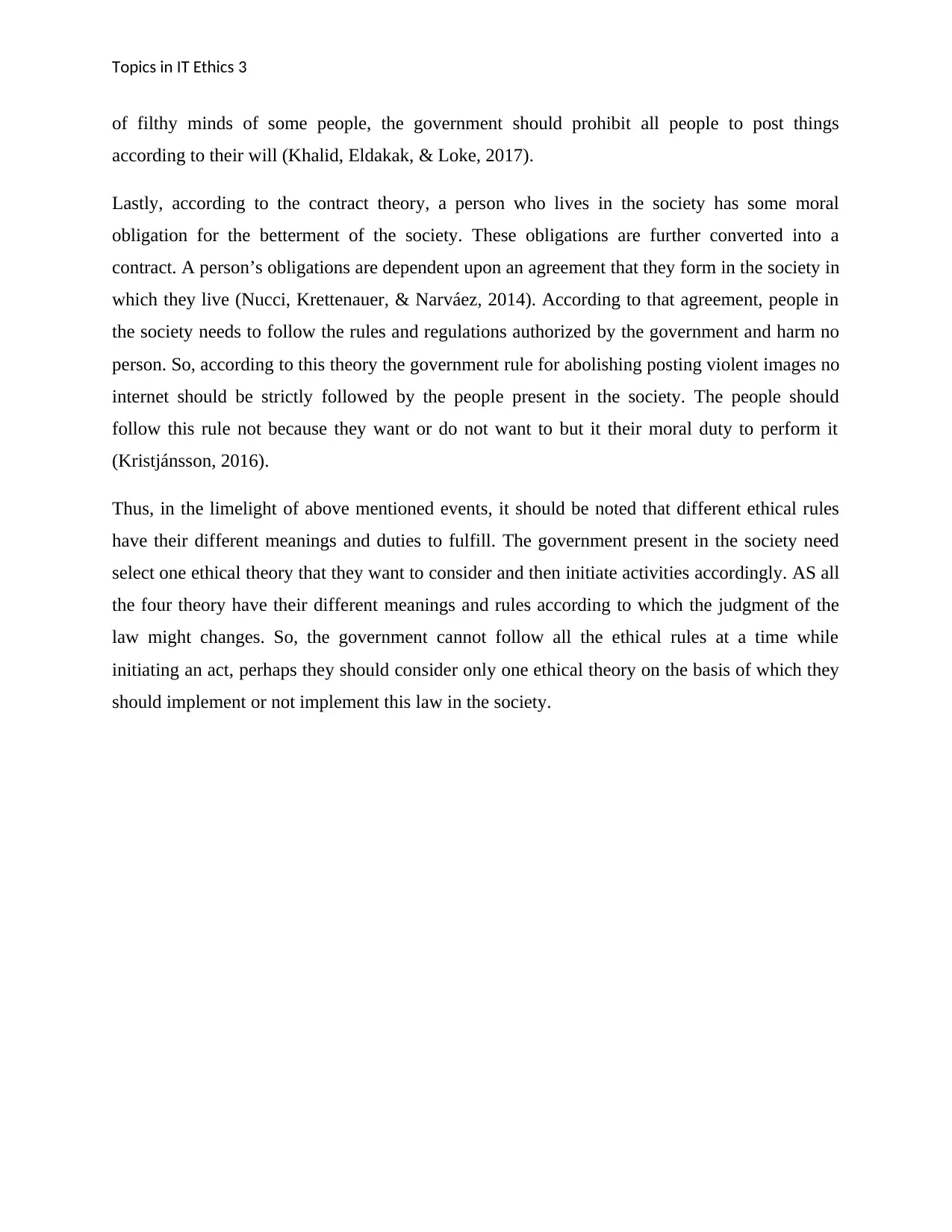
Topics in IT Ethics 3
of filthy minds of some people, the government should prohibit all people to post things
according to their will (Khalid, Eldakak, & Loke, 2017).
Lastly, according to the contract theory, a person who lives in the society has some moral
obligation for the betterment of the society. These obligations are further converted into a
contract. A person’s obligations are dependent upon an agreement that they form in the society in
which they live (Nucci, Krettenauer, & Narváez, 2014). According to that agreement, people in
the society needs to follow the rules and regulations authorized by the government and harm no
person. So, according to this theory the government rule for abolishing posting violent images no
internet should be strictly followed by the people present in the society. The people should
follow this rule not because they want or do not want to but it their moral duty to perform it
(Kristjánsson, 2016).
Thus, in the limelight of above mentioned events, it should be noted that different ethical rules
have their different meanings and duties to fulfill. The government present in the society need
select one ethical theory that they want to consider and then initiate activities accordingly. AS all
the four theory have their different meanings and rules according to which the judgment of the
law might changes. So, the government cannot follow all the ethical rules at a time while
initiating an act, perhaps they should consider only one ethical theory on the basis of which they
should implement or not implement this law in the society.
of filthy minds of some people, the government should prohibit all people to post things
according to their will (Khalid, Eldakak, & Loke, 2017).
Lastly, according to the contract theory, a person who lives in the society has some moral
obligation for the betterment of the society. These obligations are further converted into a
contract. A person’s obligations are dependent upon an agreement that they form in the society in
which they live (Nucci, Krettenauer, & Narváez, 2014). According to that agreement, people in
the society needs to follow the rules and regulations authorized by the government and harm no
person. So, according to this theory the government rule for abolishing posting violent images no
internet should be strictly followed by the people present in the society. The people should
follow this rule not because they want or do not want to but it their moral duty to perform it
(Kristjánsson, 2016).
Thus, in the limelight of above mentioned events, it should be noted that different ethical rules
have their different meanings and duties to fulfill. The government present in the society need
select one ethical theory that they want to consider and then initiate activities accordingly. AS all
the four theory have their different meanings and rules according to which the judgment of the
law might changes. So, the government cannot follow all the ethical rules at a time while
initiating an act, perhaps they should consider only one ethical theory on the basis of which they
should implement or not implement this law in the society.
Paraphrase This Document
Need a fresh take? Get an instant paraphrase of this document with our AI Paraphraser
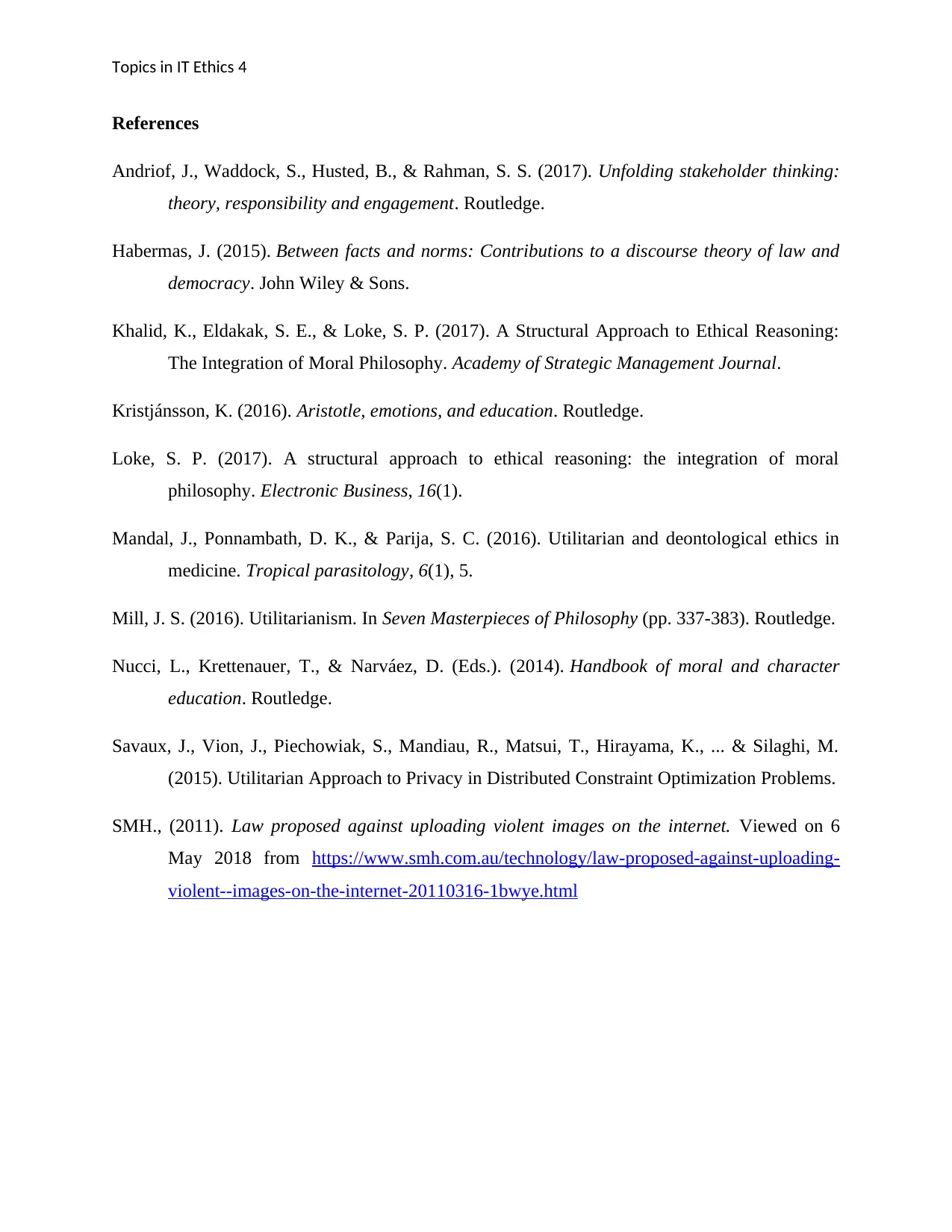
Topics in IT Ethics 4
References
Andriof, J., Waddock, S., Husted, B., & Rahman, S. S. (2017). Unfolding stakeholder thinking:
theory, responsibility and engagement. Routledge.
Habermas, J. (2015). Between facts and norms: Contributions to a discourse theory of law and
democracy. John Wiley & Sons.
Khalid, K., Eldakak, S. E., & Loke, S. P. (2017). A Structural Approach to Ethical Reasoning:
The Integration of Moral Philosophy. Academy of Strategic Management Journal.
Kristjánsson, K. (2016). Aristotle, emotions, and education. Routledge.
Loke, S. P. (2017). A structural approach to ethical reasoning: the integration of moral
philosophy. Electronic Business, 16(1).
Mandal, J., Ponnambath, D. K., & Parija, S. C. (2016). Utilitarian and deontological ethics in
medicine. Tropical parasitology, 6(1), 5.
Mill, J. S. (2016). Utilitarianism. In Seven Masterpieces of Philosophy (pp. 337-383). Routledge.
Nucci, L., Krettenauer, T., & Narváez, D. (Eds.). (2014). Handbook of moral and character
education. Routledge.
Savaux, J., Vion, J., Piechowiak, S., Mandiau, R., Matsui, T., Hirayama, K., ... & Silaghi, M.
(2015). Utilitarian Approach to Privacy in Distributed Constraint Optimization Problems.
SMH., (2011). Law proposed against uploading violent images on the internet. Viewed on 6
May 2018 from https://www.smh.com.au/technology/law-proposed-against-uploading-
violent--images-on-the-internet-20110316-1bwye.html
References
Andriof, J., Waddock, S., Husted, B., & Rahman, S. S. (2017). Unfolding stakeholder thinking:
theory, responsibility and engagement. Routledge.
Habermas, J. (2015). Between facts and norms: Contributions to a discourse theory of law and
democracy. John Wiley & Sons.
Khalid, K., Eldakak, S. E., & Loke, S. P. (2017). A Structural Approach to Ethical Reasoning:
The Integration of Moral Philosophy. Academy of Strategic Management Journal.
Kristjánsson, K. (2016). Aristotle, emotions, and education. Routledge.
Loke, S. P. (2017). A structural approach to ethical reasoning: the integration of moral
philosophy. Electronic Business, 16(1).
Mandal, J., Ponnambath, D. K., & Parija, S. C. (2016). Utilitarian and deontological ethics in
medicine. Tropical parasitology, 6(1), 5.
Mill, J. S. (2016). Utilitarianism. In Seven Masterpieces of Philosophy (pp. 337-383). Routledge.
Nucci, L., Krettenauer, T., & Narváez, D. (Eds.). (2014). Handbook of moral and character
education. Routledge.
Savaux, J., Vion, J., Piechowiak, S., Mandiau, R., Matsui, T., Hirayama, K., ... & Silaghi, M.
(2015). Utilitarian Approach to Privacy in Distributed Constraint Optimization Problems.
SMH., (2011). Law proposed against uploading violent images on the internet. Viewed on 6
May 2018 from https://www.smh.com.au/technology/law-proposed-against-uploading-
violent--images-on-the-internet-20110316-1bwye.html
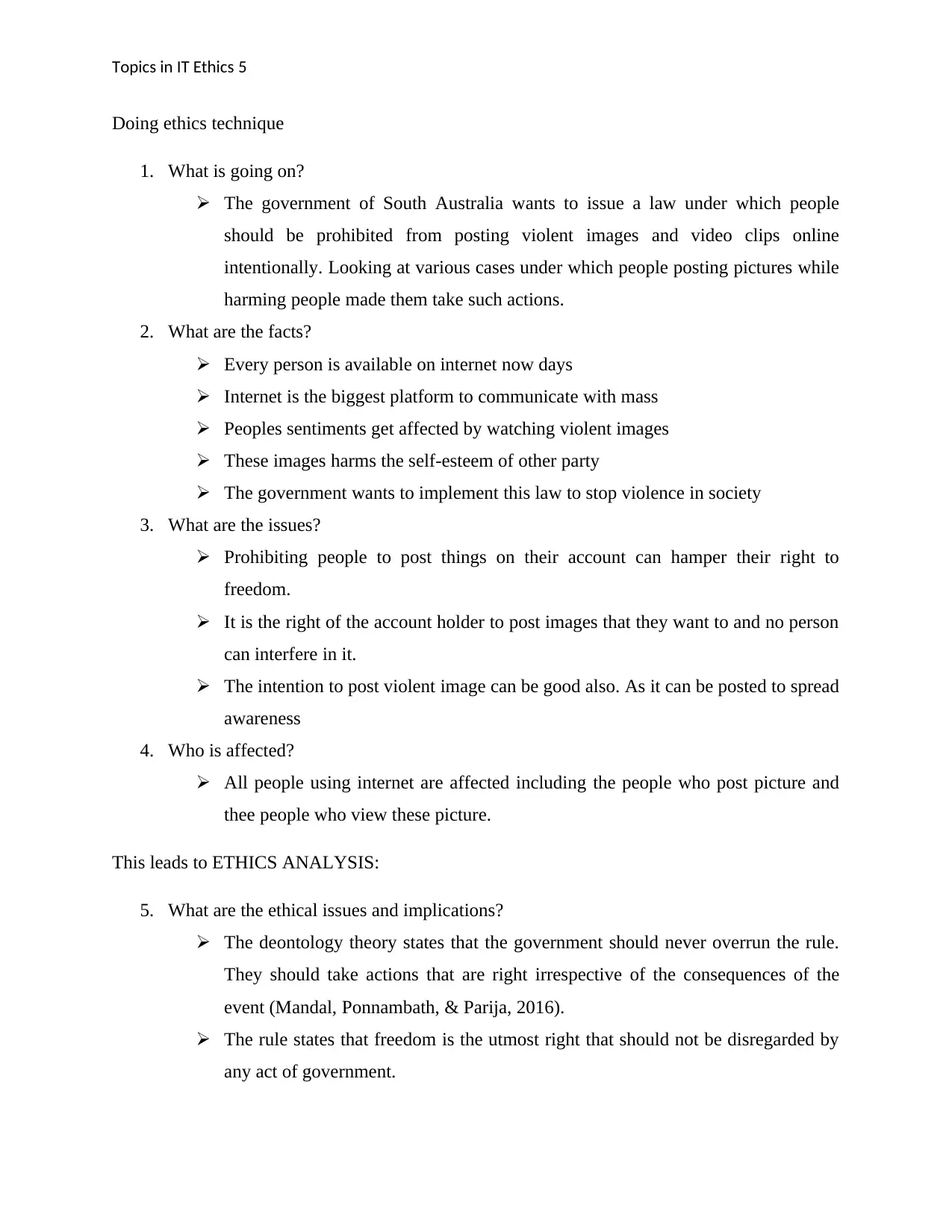
Topics in IT Ethics 5
Doing ethics technique
1. What is going on?
The government of South Australia wants to issue a law under which people
should be prohibited from posting violent images and video clips online
intentionally. Looking at various cases under which people posting pictures while
harming people made them take such actions.
2. What are the facts?
Every person is available on internet now days
Internet is the biggest platform to communicate with mass
Peoples sentiments get affected by watching violent images
These images harms the self-esteem of other party
The government wants to implement this law to stop violence in society
3. What are the issues?
Prohibiting people to post things on their account can hamper their right to
freedom.
It is the right of the account holder to post images that they want to and no person
can interfere in it.
The intention to post violent image can be good also. As it can be posted to spread
awareness
4. Who is affected?
All people using internet are affected including the people who post picture and
thee people who view these picture.
This leads to ETHICS ANALYSIS:
5. What are the ethical issues and implications?
The deontology theory states that the government should never overrun the rule.
They should take actions that are right irrespective of the consequences of the
event (Mandal, Ponnambath, & Parija, 2016).
The rule states that freedom is the utmost right that should not be disregarded by
any act of government.
Doing ethics technique
1. What is going on?
The government of South Australia wants to issue a law under which people
should be prohibited from posting violent images and video clips online
intentionally. Looking at various cases under which people posting pictures while
harming people made them take such actions.
2. What are the facts?
Every person is available on internet now days
Internet is the biggest platform to communicate with mass
Peoples sentiments get affected by watching violent images
These images harms the self-esteem of other party
The government wants to implement this law to stop violence in society
3. What are the issues?
Prohibiting people to post things on their account can hamper their right to
freedom.
It is the right of the account holder to post images that they want to and no person
can interfere in it.
The intention to post violent image can be good also. As it can be posted to spread
awareness
4. Who is affected?
All people using internet are affected including the people who post picture and
thee people who view these picture.
This leads to ETHICS ANALYSIS:
5. What are the ethical issues and implications?
The deontology theory states that the government should never overrun the rule.
They should take actions that are right irrespective of the consequences of the
event (Mandal, Ponnambath, & Parija, 2016).
The rule states that freedom is the utmost right that should not be disregarded by
any act of government.
⊘ This is a preview!⊘
Do you want full access?
Subscribe today to unlock all pages.

Trusted by 1+ million students worldwide
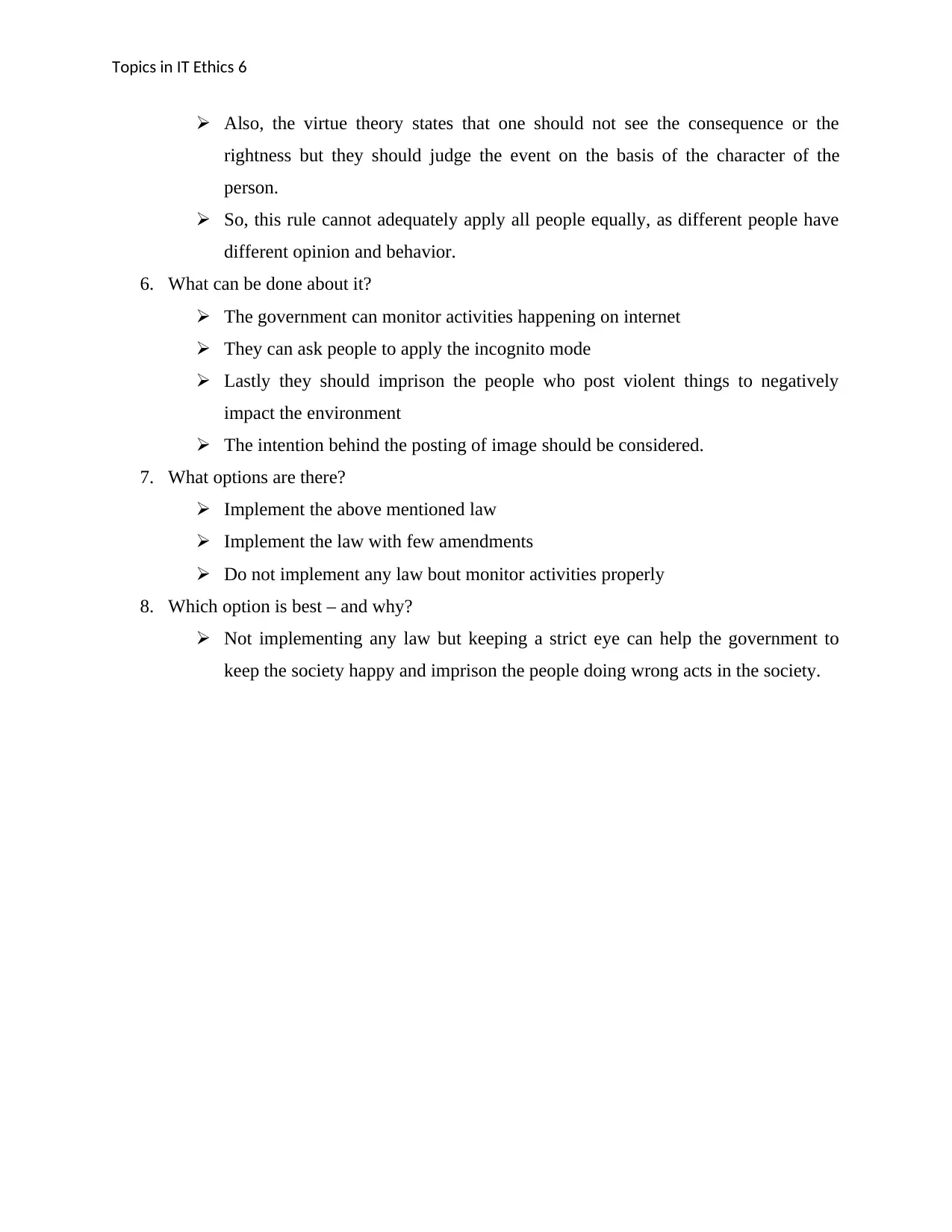
Topics in IT Ethics 6
Also, the virtue theory states that one should not see the consequence or the
rightness but they should judge the event on the basis of the character of the
person.
So, this rule cannot adequately apply all people equally, as different people have
different opinion and behavior.
6. What can be done about it?
The government can monitor activities happening on internet
They can ask people to apply the incognito mode
Lastly they should imprison the people who post violent things to negatively
impact the environment
The intention behind the posting of image should be considered.
7. What options are there?
Implement the above mentioned law
Implement the law with few amendments
Do not implement any law bout monitor activities properly
8. Which option is best – and why?
Not implementing any law but keeping a strict eye can help the government to
keep the society happy and imprison the people doing wrong acts in the society.
Also, the virtue theory states that one should not see the consequence or the
rightness but they should judge the event on the basis of the character of the
person.
So, this rule cannot adequately apply all people equally, as different people have
different opinion and behavior.
6. What can be done about it?
The government can monitor activities happening on internet
They can ask people to apply the incognito mode
Lastly they should imprison the people who post violent things to negatively
impact the environment
The intention behind the posting of image should be considered.
7. What options are there?
Implement the above mentioned law
Implement the law with few amendments
Do not implement any law bout monitor activities properly
8. Which option is best – and why?
Not implementing any law but keeping a strict eye can help the government to
keep the society happy and imprison the people doing wrong acts in the society.
1 out of 7
Related Documents
Your All-in-One AI-Powered Toolkit for Academic Success.
+13062052269
info@desklib.com
Available 24*7 on WhatsApp / Email
![[object Object]](/_next/static/media/star-bottom.7253800d.svg)
Unlock your academic potential
Copyright © 2020–2025 A2Z Services. All Rights Reserved. Developed and managed by ZUCOL.





